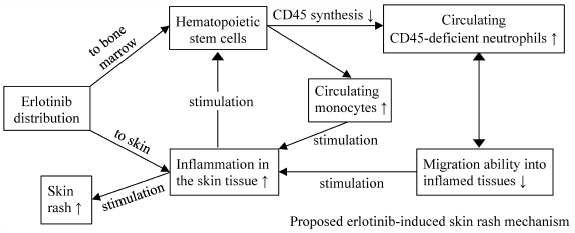- 著者
- Iqbal Julian Takuya Iwamoto
- 出版者
- The Pharmaceutical Society of Japan
- 雑誌
- Biological and Pharmaceutical Bulletin (ISSN:09186158)
- 巻号頁・発行日
- vol.44, no.8, pp.1050-1059, 2021-08-01 (Released:2021-08-01)
- 参考文献数
- 40
- 被引用文献数
- 1
Skin rash is a common adverse event associated with erlotinib therapy. In severe conditions, the rash could affect patients’ QOL. If the rash occurrence can be predicted, erlotinib treatment failures can be prevented. We designed an in vivo study that applied erlotinib regimens resembling its clinical application to evaluate possible erlotinib-induced skin rash biomarkers for humans and simultaneously observe the effects of erlotinib discontinuation, followed with or without dose reduction, on rash development. Rats were divided into four groups: placebo, constant (erlotinib 35 mg/kg on d1–d21), intermittent (erlotinib 70 mg/kg on d1–d7 and d15–d21), and mimic (erlotinib 70 mg/kg on d1–d7 and erlotinib 35 mg/kg on d15–d21). Blood sampling was performed on d1, d8, d15, and d22. The samples were used to measure erlotinib concentrations, the level of hepatic and renal function markers, immune cell percentages, and immune cells’ CD45 expression levels. Erlotinib 70 mg/kg generated high mean circulating erlotinib concentrations (>1800 ng/mL) that led to severe rashes. Erlotinib dose reduction following rash occurrence reduced circulating erlotinib concentration and rash severity. After the treatment, the escalation of neutrophil percentages and reduction of neutrophils’ CD45 expression levels were observed, which were significantly correlated with the rash occurrence. This study is the first to show that erlotinib-induced skin rash may be affected by the reduction of neutrophils’ CD45 expression levels, and this is a valuable finding to elucidate the erlotinib-induced skin rash formation mechanism.
